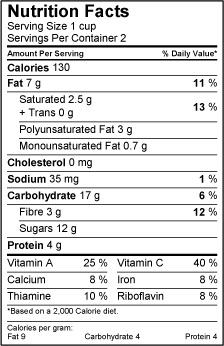|
Have you been in the situation recently where you are shopping in the grocery store and catch yourself gasping at the food prices and think “$7.99 for a head of cauliflower, $13.00 for two chicken breasts?!” Seeing these prices can make a person who is trying to eat a healthy, wholesome diet feel discouraged and frustrated. As per the University of Guelph’s Annual Food Price report, the cost of food rose 4.1 % in 2015 when it was expected to rise by only 3.0%. This rise in food cost was significantly above the rate of inflation. There are many reasons for this; the dollar losing value this past year, our high dependency on imported produce, global draughts, and living in a northern climate. All of these factors make for buying affordable, healthy food challenging. So is it possible to stick within a budget while still eating a healthy diet? Let’s explore. Instead of purchasing expensive produce such as asparagus or cauliflower, opt for items such as broccoli, cabbage, and brussel sprouts. Be flexible with your recipes and substitute inexpensive vegetables where possible. Swap your baby carrots with large bagged carrots (you can find a deal for $1.99 per 5lbs for those orange suckers!). You can also get a bag of 3lb onions for as little as $1.69, which gives you about 8 onions – more than a weeks worth. As for fruit, apples, grapefruits, oranges, and bananas are relatively inexpensive year round and remain your best value. Frozen vegetables and fruit are also a suitable option. Frozen fruit and vegetables are picked at their peak ripeness and flash frozen so nutrient damage is minimal. Taking a cost comparison, you can get a bag of 600g of fruit for under $5.00 on sale. At best, fresh berries are on for $2.50 per 200g. No deal there. If you choose to use canned, make sure you run your veggies under water to rinse out the excess sodium that is used for preserving. As for nuts, almond and hazelnut prices are at an all time high. Replace these with alternatives such as peanuts, sunflower and pumpkin seeds to reduce the cost while maintaining similar nutritional value. You can roast them, add them to your oatmeal, use them in homemade granola bars, or mix into your yogurt. They have that same crunchy nutty flavour but at a much lower price. Another way to save on cost is to reduce your consumption of meat. 2016 is the International Year of Pulses. Pulses are part of the legume family and refer to a family of dried items such as beans, lentil and chickpeas. Pulses are a great source of protein and fibre, are low in fat, and have a low carbon footprint. An easy way to incorporate pulses are replacing half of your meat with them, or opting for more vegetarian meals throughout the week.  Another great way to reduce cost is to utilize all of your food and minimize waste. Keep the stems of your broccoli and the ends of your celery and make homemade stock. Plan your meals ahead of time and make a list. It sounds old fashioned, but making a list minimizes the “oh we could use that” mindless shopping while strolling the aisles. This way you know what you are getting and may be less likely to stray from that list. But by far, the biggest way to save money is to reduce your food waste. If your produce begins to look wilted or unappetizing, throw it in a stir-fry or add it to a stew. And best before dates are more of an indicator of quality and not necessarily safety. Be grateful for our lush availability of international foods and be kind to your wallet. Healthy eating in the midst of rising food prices isn’t easy, but is possible. Emilie Trottier, RD, Sports Dietitian Registered Dietitian and Sports Dietitian at Evolved Sport and Nutrition Emilietrottier.RD@gmail.com
2 Comments
How many people look at nutrition claims on the front of food product labels when at the grocery store? Now, how about looking at the back of the packaging for nutrition facts tables and ingredient lists? Food labels serve the purpose of giving basic information about the characteristics of a product to the consumer, providing information pertaining to nutrition and health, presenting safety instructions for safe handling and storage, and acting as an advertising and promotional tool. Any information that appears on a food labels must be truthful, including the accuracy of ingredients lists in descending order of proportion, nutrition facts labels reflecting correct nutrient amounts in product, precise net quantity declared, and nutrition claims. We all can imagine what food labels look like.  Something consumers may not be aware of, is front-of-package labels act as a marketing tool for food manufacturers. Claims that appear are often given the term “health claims” despite that lack of formal recognition by government food regulatory departments. The general definition for claims by Health Canada that will be used for this paper is, “any representation in labeling and advertising that states, suggests, or implies that a relation exists between the consumption of foods or food constituents and health”. Manufacturers in recent years have had an increasing interest in using health claims. Not only do these health claims act as marketing tools, but act as educational tools to inform the public. With the growing focus on evidence linking diet, nutrition and health, consumers are becoming more aware of approaches to enhance their health, taking responsibility to make better food choices. Diet is one of the major contributing factors affecting the incidence and severity of diseases such as diabetes, coronary heart disease, and cancer. A large portion of direct and indirect health care costs come from these diet-related diseases, placing an increased strain on the medical system. The primary purpose of claims is to better inform consumers, leading to healthier food choices and better overall diet quality, resulting in prevention of chronic disease and improved health outcomes. Evidence regularly shows that there is a high awareness of nutrition claims on labels. Consumer surveys show increased perceptions of the healthfulness of food items bearing claims. The unfortunate truth is that awareness of nutrition claims does not translate into full understanding of the information provided. Inconsistent and insufficient evidence is available on the power of nutrition claims on front-of-package labeling in modifying behaviour, food choice and intake. Usage of front-of-label claims are impacted by many factors causing varied usage, including mood, time pressure, social pressure, type of product being purchased, cost, interest in nutrition, motivation, health state, literacy, and understanding of claims/ nutrition. These factors may explain why the chain of effects leading to the ultimate goal of healthier diets and obesity prevention may not be plausible.  Evidence shows that claims can lead people to categorize food as good or bad for their health. This thought process causes people to underestimate the number of calories in foods thought to be good for health, while overestimating calories in less healthy option. Individuals therefore give good foods a “health halo”, effecting the quantity consumed, resulting in overconsumption. Nutrition claims may also cause the consumer to look at individual nutrients and not foods as a whole. Claims may not be appropriate if usual consumer serving size is different from the standardized portion listed on the nutrition table. Nor do these claims provide direction on frequency of consumption of a food item in the context of the whole diet. Recent use of claims in combination with other front-of-label designs to disseminate healthfulness of a food product can be very confusing for the public. Since the use of claims on labels is voluntary, it does not guarantee the provision of valid information. As a general trend, the food industry has a tendency to highlight the good qualities of a food product, while neglecting the negative attributes, such as a food bearing a low-fat claim but is high in sodium. In Canada, the increased use of nutrition claims on food products offer the potential to change consumption. It has already been proven that nutrition claims have caused increased consumer awareness, offering a convenient way for consumers to make healthy choices. Nutrition claims offer the potential to remove barriers to eating healthy by simplifying nutrition information on labels, making it easier to understand. Much of the population’s food preference is learned and therefore can be modified through exposure and modeling. Although the downside of claims exist, learning how to read labels and understand information provided pose the potential to change food choices and eventual preference.  Alysha Coughler, RD, MSHc, PTS Sports Dietitian at Evolved Sport and Nutrition With the New Year upon us comes time for New Years resolutions and goals to change dietary and lifestyle habits to become healthier, but there’s something you need to be aware of. For the past decade, healthy eating seems to be the biggest craze and for the first part of this boom I couldn’t be more excited as a Dietitian for a more health conscious society. Unfortunately that focus on healthy eating took a turn for the worse when more and more healthcare practitioners identified Orthorexia Nervosa, a term originally coined by Dr. Steven Bratman in 1997! Orthorexia Nervosa is a medical condition where someone has reached the point of obsession with foods that they consider to be healthy. This condition is furthered by the complete avoidance of foods that would be traditionally deemed to be unhealthy. This condition is so new that it’s not even in the DSM 5 (Diagnostic and Statistical Manual of Mental Disorders: Fifth edition), which was released in 2013! But it’s a very real condition as I have seen it many times in my own practice and personal life. Furthermore, my colleagues and I also agree that the numbers are climbing drastically, but why? There are many theories that I’ve read out there on why this is happening, most of the theories out there are just speculation (which is the same in this blog post) given how new the Orthorexia Nervosa phenomenon is. The issue is that Orthorexia Nervosa isn’t like most other eating disorders, whereas the majority of eating disorders are related to a body image issue, wanting to look a certain way or related to some aesthetic desire. Orthorexia Nervosa is the obsession with trying to be as healthy as possible. With all this being said, I thought I would offer my own thoughts as to what has contributed to this sudden rise in obsessive healthy eating. One of my first thoughts is the rise of Social Media and the same rise in popularity in the Physique competition world. Now this has been a social phenomenon that occurred and has been established for quite some time now, but I remember when Facebook was exclusive to University students only. Now everyone is on, and with the rise of other social media platforms everyone seems to be an expert at nutrition to the point where “Instagram Models,” Fitness Models and Personal Trainers are giving out nutrition tips that are wildly unfounded in research or logic. Societies have always established a poor connection with how someone’s body looks and their knowledge on nutrition. For example “Oh he must know how to eat properly because he has a six-pack abs and lots of muscles.” This is such a fallacy in logic. What this one person has done is figure out what works for him or her but that does not mean that they have the complex training to actually give advice on the topic of nutrition or health. Another thing that needs to be mentioned is the juxtaposition in the physique competitor world where healthy eating and physical activity is held in such high regard, however there is no second thought is given to the damage that the anabolic steroids and other pharmaceutical methods that are used achieve that body aesthetic. My second thought for the rise in Orthorexia Nervosa is the simultaneous rise of the fad diets and the popularity of detox cleanses. Now fad diets have existed prior to this phenomenon but ever since the rise in Social Media it’s taken on a whole new level. From Paleo to Self-Diagnosed Gluten-Free to Veganism to Juicing, these extremely strict ways of eating have created a black-and-white culture of foods and their health value. Now let’s get one thing straight, this is not an attack on these eating styles but rather I bring this up to highlight my point; restrictive eating became much more popular and accepted with these diets. It also doesn’t help that anyone that tries these diets out with some form of success immediately advertises to the world that all of their health problems have been solved to the point where the promotion of said diet becomes abusive (seriously, there are a ton of people out there that will harass others online and in real life if their food beliefs are not in line with anyone else’s). What these people don’t understand is the profoundly deep connection that people actually share with food. Food is more than just food, food is culture, religion, political, ethical and a person’s identity, harassing others to conform to your deeply personal choice to eat the way you do is an attack. Someone may have chosen a restrictive eating style for their own reasons, but don’t ever assume that other people need or want to do the same. My third and final thought is the rise of extreme body image issues that have been exacerbated by social media and highly unrealistic expectations. The world of advertisement, media, the fitness industry and social media posters have created an atmosphere an unsafe enviornment for anyone suffering from a body image issue, which are a lot! Through my discussions with colleagues and other health professionals there seems to be a general consensus that the obsession with healthy eating is used as a cover up to body image issues. One of my colleagues actually raised a very good point that for someone with a body image issue control is really important, having such an obsession with healthy eating provides some form of. This makes complete sense and it does explain why we’re seeing it in younger and younger people. For many, body image issues stem from a very young age. It can often come from peers, advertisement or their own parents. Additionally, at a younger age where there typically isn’t a lot of ability for a child to express their individuality, food choices can be used as a vehicle to express their individuality.  I’m glad there’s increased interest in healthy eating and healthy living, but not if it’s going to create it’s own set of problems. I’m glad that there are more and more people speaking out about the dangers of these obsessions. One person in particular, Jordan Younger, is telling her story about how Veganism and extreme dieting negatively impacted her life in her recently published book ‘Breaking Vegan.’ Yes, I agree that health is important, but physical health should not come at the expense of your social, mental and emotional health. True health is a balancing act. It’s being able to incorporate foods that aren’t considered healthy into a lifestyle that also looks at healthy foods and an active lifestyle. It’s the ability to engage in social events without having obsessive thoughts about if all the ingredients are locally sourced or vegan or whatever. Once this balance is disturbed then health no longer exists, because your physical health has come at the expense of another aspect of your health. So step away from social media and really start to question where your information is coming from, because health has a variety of meanings all profoundly personal. No two definitions of health are the same, some people will value one thing over another but at the end of the day we will all be happiest when we own our own definition of health. Ben Sit, RD, Sports Dietitian President of Evolved Sport and Nutrition Complete Lifestyle Management |
Categories
All
Archives
November 2021
|
- Home/ News
- About
- Services/ Store
- Media
-
Learning Center
- ESN Athletic and Healthy Lifestyle Learning Center >
-
Professional Learning Center
>
-
The ESN Sports Nutrition Certificate
>
- ESN Learning Center - Sports Nutrition Certificate Level 1 >
- ESN Learning Center Sports Nutrition Certificate Level 2 >
-
ESN Learning Center - Sports Nutrition Certificate Level 3
>
- Module 1 - Periodization for the Athlete
- Module 2 - Nutrition Strategies to Optimize Recovery
- Module 3 - Sports Nutrition for Children and Young Athletes
- Module 4 - Sports Nutrition for the Aging Athlete
- Module 5 - Nutritional Strategies for Injury Prevention and Concussions
- Module 6 - Nutritional Strategies for the Travelling Athlete
- Module 7 - Tournament Nutrition Strategies
-
The ESN Sports Nutrition Certificate
>
- Contact
Proudly powered by Weebly






 RSS Feed
RSS Feed